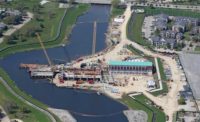The U.S. Army Corps of Engineers has released for public comment its proposal for the Gulf Intracoastal Waterway West Closure Complex, a surge protection project that will include a 20,000- to 25,000-cu-ft-per-second capacity pump station, the largest in the nation. The GIWW Closure Complex will likely be the largest component of the Greater New Orleans Hurricane and Storm Damage Risk Reduction System. Located just south of New Orleans on the west bank of the Mississippi River, it is intended to reduce risk from a storm event with an intensity that has a 1% chance of occurring in any given year.
The Corps’ proposed design, detailed in Individual Environmental Report 12, which is available at www.nolaenvironmental.gov, will include floodwalls, earthen levees and navigable floodgates, as well as the pump station, which is required to evacuate storm-water. The project will likely exceed in cost and complexity the $695.4-million design-build contract already awarded for the Inner Harbor Navigation Canal storm-surge barrier, which broke ground on Dec. 4.
“The GIWW Closure Complex would be the single most significant risk-reduction project being constructed on the west bank [of New Orleans],” says Tim Connell, project manager. “The structure would remove approximately 26 miles of levees and floodwalls from the first line of defense against storm surge.”
While reducing risk, the project is designed to meet the needs of the navigation industry and minimize impacts to Bayou aux Carpes, a wetland of national significance, Connell says.
The Corps released IER 12 on Jan. 5 for a 30-day public comment period. The Corps also will hold a joint hearing with the U.S. Environmental Protection Agency to further collect and evaluate public comments. That hearing is tentatively scheduled for Feb. 11 at the New Orleans district of the Corps.


Post a comment to this article
Report Abusive Comment